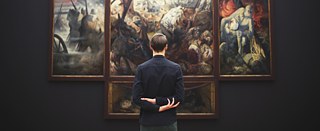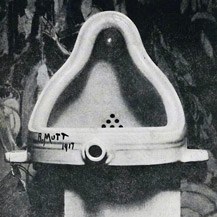The Elite in the Arts | Visual Arts
Dada: Beyond "Elite" and "Popular"

The artists, writers, performers and provocateurs known as Dada broke down the polarities of “elite” and “popular,” and transformed the arts. Between 1916 and 1924, they not only reworked the concept of “art,” but also remade popular forms and materials, turning items of everyday culture into powerful manifestations of complex concepts and questions. Their goal was a critique of bourgeois society’s blind spots, the conservative class’s definitions of politics, religion, and art, which, they believed, had opened the door to World War I’s horrors and turbulent aftermath.
Against this “deadened” world, Dada deployed its jolting “anti-art” tactics, first in Zurich, and then in Berlin, Cologne, Hannover, New York, Paris, and beyond. Wherever it went, Dada’s difficult, sometimes contradictory, strategies drew both audiences of the like-minded and those enticed by the shock of the new and unpredictable.
Dada began in February 1916 at Zurich’s Cabaret Voltaire, a small, smoky bar that became an “artists’ club, exhibition hall, pub and cabaret”.1 Escaping into neutral territory, the international group of Hans Arp, Tristan Tzara, Marcel Janco, Sophie Taeuber, Hugo Ball, Emmy Hennings, and Richard Huelsenbeck “sang, painted, made collages and wrote poems” while “guns rumbled in the distance.” Their “multimedia” cabaret allowed for individual experimentation while they proclaimed shared goals of independence, reinvigorated consciousness, and an end to cultural stagnation and war. They hung Cubist paintings, Expressionist posters, and abstract masks. They played popular songs and music, read sound poems and manifestos, and staged satirical shows. Soon the Cabaret attracted both the committed and curious who came for performances like Hugo Ball’s Karawane, a “nonsense poem” he read while dressed in a cardboard costume before an increasingly “frenzied” audience.

Stieglitz’s photograph appeared in Duchamp’s The Blind Man, one of many “little magazines” published by the avant-garde. Like the Cabaret, the magazine format’s diverse but integrated contributions asserted Dada as a unified community of independents, interrogated the boundaries between art and popular culture, and documented and disseminated their work. Dada’s periodicals – Zurich’s Cabaret Voltaire (1916) and Dada (1917–1921), Berlin’s Der Dada (1919–1920), Hannover’s Merz (1923–32), and Cologne’s Die Schammade (1920), among many others – were printed in smaller numbers for specialized, but increasingly international, readers. Playing with typical magazine formats, the journals mixed texts and images in unusual ways, disrupted advertising and design conventions, and spread vanguard concepts to ever-broadening audiences.
Berlin’s political situation propelled Dada toward a critical outlook and aggressive stance. From 1917 to 1920, Huelsenbeck, with George Grosz, John Heartfield, Raoul Hausmann, Hannah Höch, Johannes Baader, and others, furthered Dada’s interventionist tactics to protest militarism, nationalism and the oppressive forces splintering the new Weimar Republic. Berlin’s “Club Dada” produced paintings, manifestos, collages, assemblages, abstract poetry, performances and actions in a variety of formats and venues. Always interested in strategies of mediation, Berlin Dada critiqued the mass media’s misleading narratives formed from texts and images, especially photographs. Photomontage became their weapon of choice. The cut-and-paste aesthetic, as in Hannah Höch’s 1919 Cut with the Dada Kitchen Knife the Last Weimar Beer Belly Cultural Epoch in Germany laid bare the constructed nature of the “truths” circulating in the popular press in an increasingly nationalist environment.

Both Dada’s “life” and “death” were short-lived. Artists and writers, seeking the sources of modern art or solutions to old ways of thinking, “resurrected” Dada in the postwar era. The Dadas’ early manifestos, memoirs, and histories of the movement were soon translated and read by international audiences. In 1951 American painter Robert Motherwell reintroduced Dada through his groundbreaking publication of newly translated and presented Dada sources, The Dada Painters and Poets: An Anthology, which became an influential sourcebook for artists and scholars. In 1954 German artist and writer Willy Verkauf published Dada: Monograph of a Movement, which, along with Motherwell’s volume, sowed the seeds of the watershed 1958 Düsseldorf exhibition Dada – Dokumente einer Bewegung.

1 Richard Huelsenbeck, Memoirs of a Dada Drummer, ed. Hans J. Kleinschmidt (Berkeley: University of California Press, 1974), p. 9.
To the Overview